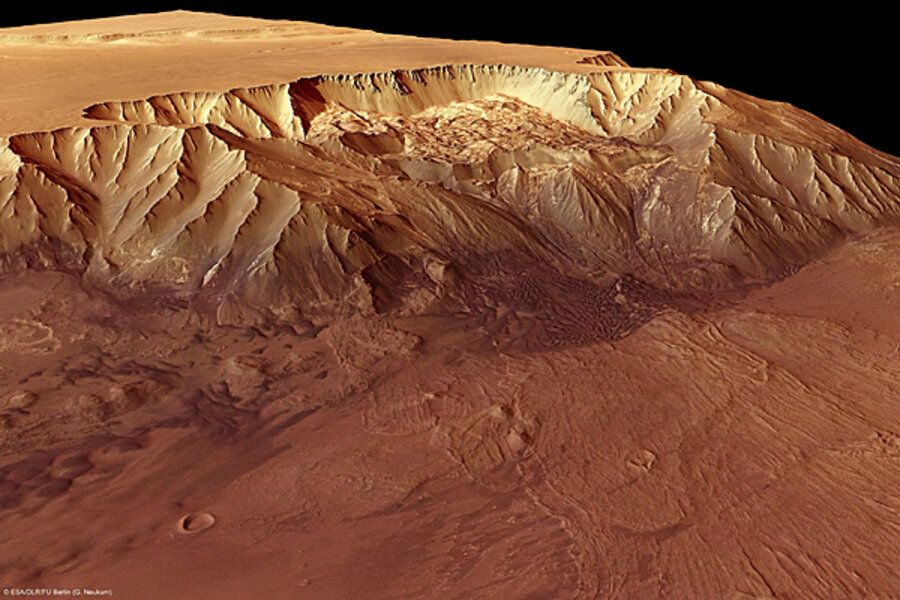Mars may have been habitable underground, new research suggests
Loading...
An ancient meteor strike on Mars has revealed the first direct evidence of how warm liquid water may have shaped a habitable underground environment.
Images taken by NASA's Mars Reconnaissance Orbiter have revealed the first carbonate rocks found inside Leighton Crater at a level that was once buried 4 miles (6 km) below the red planet's surface.
Carbonates hold carbon dioxide and can form readily in the presence of water, but have previously been found only in a few scattered locations on Mars. [Graphic: How Craters Expose Martian Underground]
IN PICTURES: Mars Spirit rover: What a long-range trip it's been
This first-time discovery of carbonates in an underground location points to a warmer epoch in the ancient Martian past with more atmospheric carbon dioxide, as well as ancient seas. The carbonates also turned up alongside silicate minerals and clays that suggest the presence of hydrothermal systems — similar to the deep sea vents on Earth.
"This discovery doesn't really hint at life, but it does reveal a very strong candidate for a habitable environment, perhaps the best discovered so far," said Paul Niles, a planetary geologist with the NASA Johnson Space Center in Houston.
The ancient rocks may date back as far as 3.5 or 4 billion years, according to Joseph Michalski, a planetary geologist at the Planetary Science Institute in Arizona. That means they don't necessarily reflect the Martian underground as it exists today, but they do point to processes which could make the Mars subsurface a habitable place.
Researchers have long looked to the underground environment in hopes of finding Martian life, because cold, dry conditions coupled with ultraviolet radiation on the surface of Mars makes existence up above unlikely.
"The subsurface environment provides a warm, stable environment that should be conducive for life to evolve given our limited understanding of that process," Niles said in an e-mail.
The research is detailed in the Oct. 10 issue of the journal Nature Geosciences.
The methane mystery
The findings may also prove a huge step toward solving the mystery of methane gas on Mars today. Such gas could originate from either methane-burping microbes or non-organic geological processes, but so far no signs of life have turned up as the culprit.
A recent study showed that methane disappears from Mars within less than a year — another sign that something must be constantly creating the methane on the red planet.
But now researchers may have a geological, rather than biological, answer.
Hydrothermal processes with warm liquid water can chemically interact with rocks in a way that produces methane, and the recent Leighton Crater study has laid out strong evidence of hydrothermal systems having at least existed on Mars.
A triumph of the geological explanation does not automatically rule out the chances for life, said Michalski, who coauthored the recent study with Niles. That's because hydrothermal systems would make the underground Martian environment an even more attractive-looking place for life to hide out.
"That is what's cool about Martian methane; it either formed organically or in an environment that's conducive to habitability," Michalski told SPACE.com.
Scratching the surface
Finding out more about the Martian underground has been difficult because of a volcanic upper crust that hides what lies beneath. The Leighton Crater itself sits just southwest of a giant dormant Martian volcano named Syrtis Major, between the northern lowlands and the southern highlands.
If researchers can find other craters that provide more windows into the underground scene, they could confirm a sneaking suspicion about carbonates being spread across a large region of Mars. Such minerals could prove invaluable for their record of water's history that dates back to the warmer, carbon dioxide-rich period of ancient Mars.
"The difficulty with Mars is we only see the surface layer for a long time [because of a lack of plate tectonics]," Michalski explained. "The best way to look at the deeper part of the crust is to look at impact craters several kilometers down."
Future robotic missions beyond the Mars Science Laboratory, NASA's SUV-sized rover slated to launch in 2011, could also target areas similar to the Leighton Crater so that they can study the chemical makeup of the rocks in detail.
Meanwhile, the Mars Reconnaissance Orbiter's instruments — the Compact Reconnaissance Imaging Spectrometer for Mars and High Resolution Imaging Science Experiment — continue to pay off for researchers more than five years since the probe launched.
"These missions are part of a big group effort," Michalski said. "Even though there are just two authors on the paper, we never want to give impression that we're working alone."
IN PICTURES: Mars Spirit rover: What a long-range trip it's been





